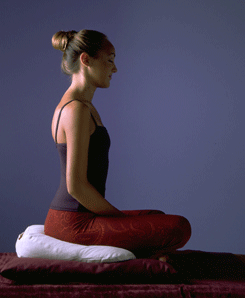
If Zen Buddhism has one method that is indispensable to realizing enlightenment, it would be the practice of meditation.
In fact the word Zen means meditation, so Zen Buddhism is Meditation Buddhism. Meditation is also the fifth of the six paramitas, the attitudes and actions that the Buddha said will lead to full realization of who we really are.
Paramita means raft; that is, the raft which will take us to the other shore. On this shore, we are caught up in desires, opinions, preferences and conditioned beliefs; on the other shore, we realize how our human tendencies limit our understanding of reality and control our interactions with the world. When we reach the other shore, we see our lives from “big mind”; on this shore, we operate out of “small mind”.
When we live out of small mind, we only care about increasing what gives us pleasure and avoiding what gives us pain. Big mind, on the other hand, cares about increasing happiness and reducing suffering for all beings. Meditation, if done correctly, will introduce us to big mind.
Before I can talk about what meditation is, I have to talk about what it is not. Often when I mention that I teach meditation, people will say, “Oh, I’ve meditated for years.”
Then they go on to describe experiences of guided visualizations, concentration exercises or mindfulness practices.
These activities are all beneficial and will produce relaxed states of mind, but they are not what I mean when I say, “Zen meditation.”
At the Creston Zen Centre, I teach shikantaza, or “simply sitting”. This is the practice that led Buddha to his enlightenment, and it involves specific sitting postures and a precise discipline of the mind.
I need to be with someone to teach postures, but even though words about meditation are nothing more than a finger pointing at the moon, I can explain what the mind does during meditation.
But it is important to remember that to really know the moon, it is necessary to actually meditate, not just read about it.
After learning to hold one of the correct postures, attention shifts to what is happening in the mind.
It is important not to attach to any thought, sensation or emotion; rather, think of these inevitable activities of mind as clouds passing through an empty sky. They arise spontaneously and, if we don’t grasp them or reject them, they float away.
Many beginning meditators conclude that because mental phenomena continue while they are meditating, they are doing it wrong. This is a mistake in thinking, and they have missed the main point, which is to not get caught up in mental experience.
In this way, awareness will sink below the surface waves of habitual thought and rest in the depths of the ocean of wisdom.
There are many known benefits to meditating and many people start meditating because of them. Some of the benefits are physical and others are psychological.
Doctors recommend meditation as a way to reduce stress and, therefore, susceptibility to stress-related illnesses; psychologists recommend meditation as a way to relieve mental and emotional distress. But these are only side effects of a regular meditation practice.
For those who meditate daily, meditation itself is sufficient reason for meditating. And as one Zen master has put it, we learn to meditate with “no gaining mind.” Herein lies the seed of enlightenment.
Author : Kuya Minogue
Source : www.crestonvalleyadvance.ca




